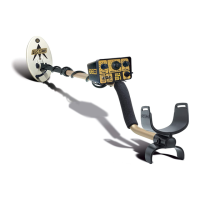21
FALSE SIGNALS
A false signal occurs when something that shouldn't, sounds like
a good target. For example the Gold Bug may detect metal in your
boots if you swing the search coil too close to your feet. Here's
some other sources of false signals and what to do about them.
1. HOT ROCKS: Mineralized rocks that respcnd like
metal. SOLUTIONS: Most hot rocks seem to be on
top of the ground so you can just kick them out of
the way and recheck the ground beneath them.
The Gold Bug will ignore some hot rocks and certain
types of hot rocks have their own distinctive sound
which you'll soon learn to recognize. Or you can
"tune-out" most hot rocks in the air or on the ground
by adjusting the ground reject knob right over the
rock. If it's a nugget you won't be able to tune it
out unless it's very small. Many strong hot rock
signals will disappear rapidly when you lower the
Sensitivity level, whereas a strong nugget signal will
just get weaker.
2. HIGHLY MINERALIZED SOIL: Unfortunately, this is
where most nuggets are found. Fortunately, the
Gold Bug will handle all but the very worst.
SOLUTIONS: Ground adjust very carefully and often.
Lower the sensitivity. Search in the Auto-Tune
mode. Ground adjust to a height just high enough
to eliminate most false signals and adjust your stem
length to sweep at that height.
3. DISSOLVED SALTS: On the beach or inland.
SOLUTIONS: Same as highly mineralized soil.
4. JUNK: Nails, pull tabs, beer cans, etc. The Gold
Bug was designed for extreme sensitivity to small
bits of gold. That meant no trash "discrimination".
We've found that even the slightest degree of
discrimination will interfere with a detector's ability
to detect gold. So the Gold Bug detects all metals.
SOLUTIONS: Fortunately there's not much junk in

